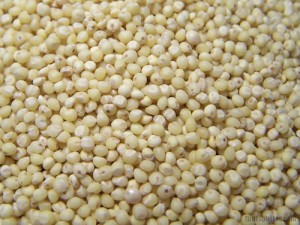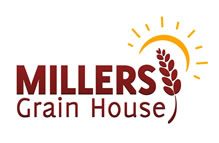 Low gluten and gluten-free items can be very expensive to buy in the store. So if you want to know what you’re getting and if it ‘s right for your gluten-free or lower gluten diet, it would be good to learn a little more about the grains you can use. I began my journey in home-milling because of a diagnosis of gluten sensitivity. Thankfully I found it was the processing of wheat flour that was my issue, not the gluten (as is the case in many people’s mis-diagnosis) and I can again eat freshly milled whole wheat. But I did learn of several grains that work well for a lower gluten or gluten-free diet.
Low gluten and gluten-free items can be very expensive to buy in the store. So if you want to know what you’re getting and if it ‘s right for your gluten-free or lower gluten diet, it would be good to learn a little more about the grains you can use. I began my journey in home-milling because of a diagnosis of gluten sensitivity. Thankfully I found it was the processing of wheat flour that was my issue, not the gluten (as is the case in many people’s mis-diagnosis) and I can again eat freshly milled whole wheat. But I did learn of several grains that work well for a lower gluten or gluten-free diet.
Because these grains all contain a trace to no gluten, they will all require some kind of binding agent in the recipe in which you use them. Gluten protein forms strands to hold dough together when baking. These grains do not have those strands so you cannot replace the milled flour of a low to no gluten grain exactly for wheat flour.
Millet (pictured above) is one of the staples in a gluten free diet. Millet can be cooked as a replacement for couscous (which is a wheat pasta, not a grain) or milled into a flour.
Quinoa is another low gluten grain. It is very high in protein and also cooks well whole.
Rice is a gluten-free grain. When milled the flour is very fine and suitable for thickening sauces.
Rye is an extremely low gluten grain. The flour is suitable for baking flat breads and using in batter bread mixtures.
Corn is low gluten. There is a trace amount of gluten & starch in some corn meals.
Oats can contain a trace amount of gluten. If you suffer from Candida or Celiac’s , be sure the oats you purchase are labeled ‘Gluten-Free’ since not all oats are gluten free.
Spelt is another grain often used in low to no gluten diets, but it does indeed have trace amounts of gluten in it. It can be kneaded but only for a short time after which over kneading causes the dough to become very sticky.
Kamut is not low or gluten-free. Kamut is an ancient grain akin to today’s wheat derivative.
Let me encourage you that if you have been diagnosed with a gluten sensitivity or a gluten intolerance, you may be able to enjoy whole wheat bread again if you mill the wheat at home and use it fresh. However, if you have been diagnosed with Candida or Celiac’s consider milling these low to no gluten grains at home to save yourself some money and give you variety in your diet.
 I am regularly asked: “Why should I mill whole wheat and grains at home“? It’s certainly an important question, and one that I asked myself when I first became interested in whole wheat and grains. Now, I know why it is so important!
I am regularly asked: “Why should I mill whole wheat and grains at home“? It’s certainly an important question, and one that I asked myself when I first became interested in whole wheat and grains. Now, I know why it is so important!
On my weekly radio show, I explore the topic and offer some insights. We want to share that recording with you and hope you will offer your comments below.
We certainly want to invite you to attend our weekly live show, “Encouragement in the Kitchen.” If you are unable to attend, we record the shows and post the audio recordings in our radio archives section.
We always love to hear your comments.
Best Blessings!
I hope you’ve had the chance to view our daughters’ video: Pancakes from Scratch. Below the video is the (whole) recipe and a little history behind this recipe that is a Miller Family Weekend Staple.
Usually every Sunday, we have either Whole Wheat pancakes made from scratch or Whole Grain Waffles made from scratch. As the girls show you above, it is actually quick and simple to mix all the dry ingredients together in one container and all the wet ingredients together in another the night before and have easy, almost instant Whole Wheat Pancakes faster than a box mix.
Heart-healthy Whole Wheat Pancakes
Wet Ingredients:
2 1/2 Cups of Low Fat Buttermilk
1/2 Cups Egg Whites
2 Whole Eggs
1/4 Cups Canola Oil
1 tsp Vanilla Extract
Dry Ingredients:
4 Cups Fresh-Milled Whole Wheat (white wheat) Flour
2 tbsp Sugar
1 tsp Baking Soda
1 tsp Salt
2 1/2 tsp Baking Powder
Just follow their lead for instructions!
If you have left over pancakes (we do that on purpose) allow them to cool on a cooling rack and place in a zip-lock bag with wax or parchment paper between them and freeze. They pull out singularly and toast in a toaster to the perfect pancake once again! Great for those mornings on the go!
By the way, the ‘Yellow Bowl’ featured in many of our videos is the famous yellow bowl that has been in my newsletters before. It is one of the inanimate objects I would try to grab in a house fire. The reason is because it was one of the first things given to me by my mother-in-law (who also influenced my and the daughters’ love of cooking) and because we have so many family meals together that the beginnings of which start in that yellow bowl. It, it priceless only because it links me to my greatest gift on earth, my family.
I hope you enJOY and become a part of the Millers Grain House extended family by subscribing to our Newsletter. You’ll get free recipes!!


